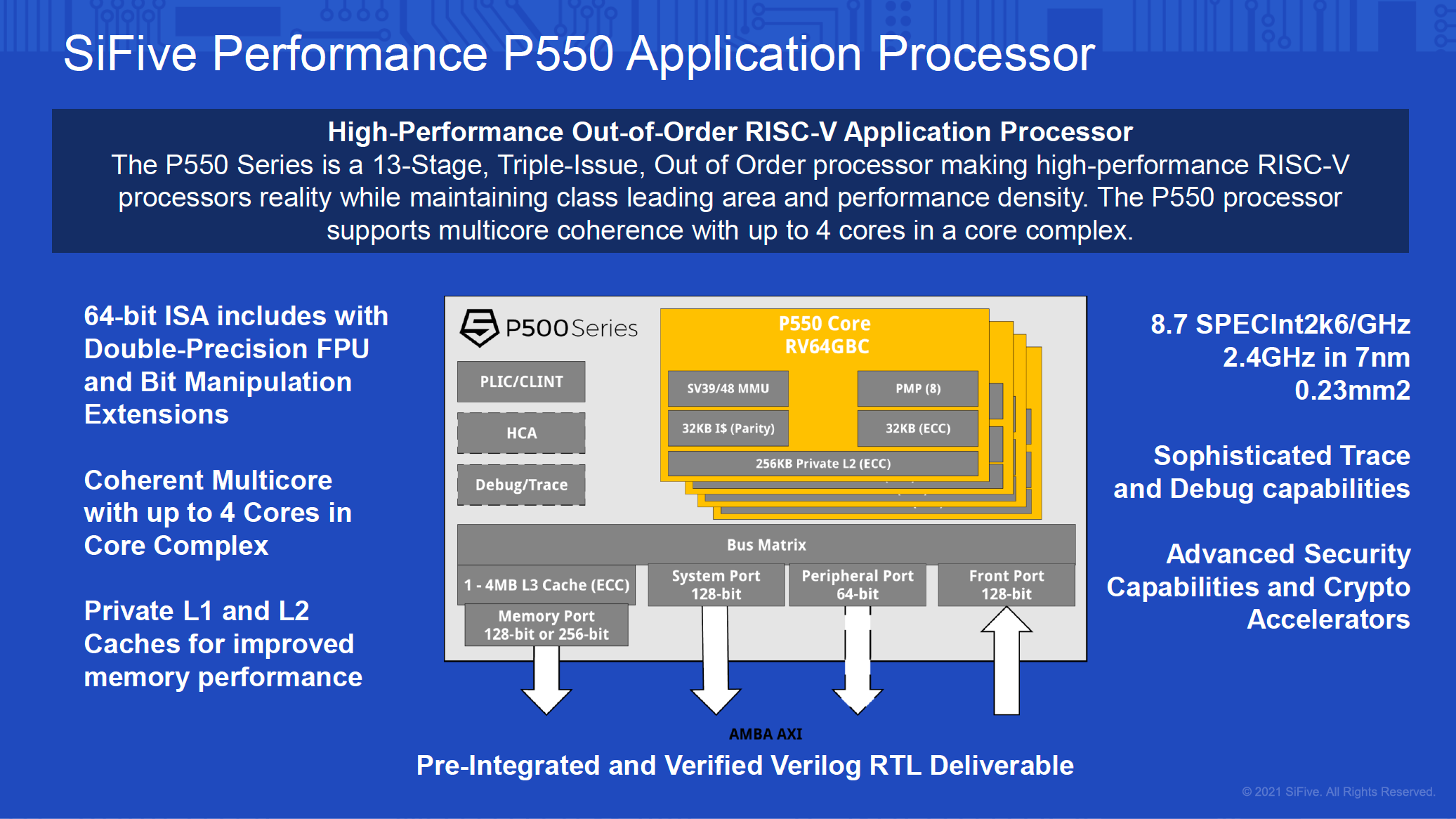SiFive Envisions 128-Core RISC-V SoCs as Gap With x86 and Arm Closes
SiFive: RISC-V has no limits.
SiFive emerged from stealth mode as a developer of small, low-power cores for microcontrollers in 2016. By late 2020, the company had a chip that could run Linux and this week said that it developed a CPU core that is comparable to modern offerings designed by Intel and Arm. The company believes that such high-performance designs could be used for a wide variety of applications, including server-grade system-on-chips with 128-cores.
SiFive's next-generation high-performance core "is within reach of Intel's Rocket Lake family […] and Arm's Cortex-A78 design […] in terms of single-core performance," James Prior, senior director of product marketing and communications at SiFive, told The Register. The details are scarce at the moment, but Prior implies that the next generation core is architecturally similar to its existing Performance P550 design, but is enhanced in all directions to extract higher performance.
SiFive's Performance P550: Fast
Earlier this year SiFive introduced its new Performance-series P550 general-purpose core based on the company's 64-bit U84 microarchitecture with a 13-stage, triple-issue, out-of-order pipeline that is aimed at multi-core application processors. The P550 core features private 2x32KB L1 and 256KB L2 caches, a data precision FPU with bit manipulation extensions, and support for multicore coherence configurations with up to four cores with a unified 4MB L3 cache in a core complex.
The company claims that the P550 core measures 0.23 mm2 when implemented in a 7 nm fabrication process and can operate at around 2.40 GHz. As for performance, the P550 delivers a SPECINt 2006 score of 8.65/GHz, which is comparable to performance of contemporary Arm and x86 cores. Meanwhile, SiFive says that the P550 offers a three times performance uplift per mm2 compared to Arm's Cortex-A75.
The P550 is available for licensing from SiFive. Since this is only a CPU core, licensees can add all kinds of special-purpose accelerators, IP, and I/O interfaces to them to get a unique system-on-chip that will address their needs (or targeted market segments/workloads).
SiFive's Performance P550: Furious… With up to 128 Cores per SoC
SiFive's next-generation core for performance demanding applications seems to be based on a very similar microarchitecture as the P550, but this one is actually a quad-issue out-of-oder microarchitecture with a higher performance per clock. In addition to a wider issue, the future core will also have larger L1 caches (up to 128KB), and up to 2MB private L2 cache. In addition, it supports multicore coherence with up to 16 cores with 16MB L3 cache in a complex.
SiFive claims that the next-gen Performance core can offer 50% higher performance compared to the P550. Furthermore, it will be possible to scale designs all the way to 128 cores and address performance-hungry applications. Since SoCs with 128 cores are used in virtualized environments, the core also adds features like hypervisors and interrupts. Meanwhile, with performance-per-core on par with Arm's and Intel's latest microarchitectures, SiFive's next-generation core could address high-performance computing (HPC) applications over time, just as envisioned by RISC-V International, the organization that oversees the development of the RISC-V instruction set architecture. Though, we would expect HPC customers to want something more proprietary from SiFive.
Get Tom's Hardware's best news and in-depth reviews, straight to your inbox.

Available Next Year
James Prior says that the next generation core will be available as an RTL deliverable next year. Customers will also be able to test drive the core on FPGA models.

Anton Shilov is a contributing writer at Tom’s Hardware. Over the past couple of decades, he has covered everything from CPUs and GPUs to supercomputers and from modern process technologies and latest fab tools to high-tech industry trends.
-
aaronfranke ReplySiFive emerged from stealth mode as a developer of small, low-power cores for microcontrollers in 2016. By late 2020, the company had a chip that could run Linux
The HiFive Unleashed was released on February 1, 2018 and it could run Linux.
On Reddit, user brucehoult said:
That's kind of a bad start to the article given that I already owned a HiFive Unleashed running Linux in March 2018.
-
korekan just a matter of time ai chip can translate instruction set almost without delay by that time it doesnt matter what kind cpu is i think,Reply
you can use arm, x86, i386 at any chip -
lazyabum I hope RISC-V has limited prices. New technology doesn't mean a thing if it's too expensiveReply -
Findecanor I think that high multi-core processor could become interesting for the data center ...Reply
HPC customers would want the Vector extension though, which is currently in review.
